
Alfa Laval AB is a Swedish company, founded in 1883 by Gustaf de Laval and Oscar Lamm. The company, which started in providing centrifugal separation solutions for dairy, now deals in the production of specialised products and solutions for heavy industry. The products are used to heat, cool, separate and transport such products as oil, water, chemicals, beverages, foodstuffs, starch and pharmaceuticals.
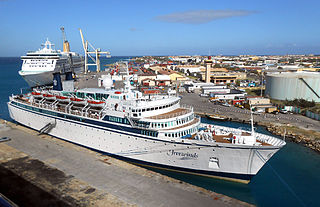
MV Freewinds is a former cruise ship operated by International Shipping Partners and owned by San Donato Properties, a company affiliated with the Church of Scientology. She was built in 1968 by Wärtsilä Turku Shipyard in Turku, Finland, for Wallenius Lines as MS Bohème for service with Commodore Cruise Line. She was the first cruise ship built in Finland. Her ownership passed to a Church of Scientology-controlled company in 1985.

A cargo ship or freighter is a merchant ship that carries cargo, goods, and materials from one port to another. Thousands of cargo carriers ply the world's seas and oceans each year, handling the bulk of international trade. Cargo ships are usually specially designed for the task, often being equipped with cranes and other mechanisms to load and unload, and come in all sizes. Today, they are almost always built of welded steel, and with some exceptions generally have a life expectancy of 25 to 30 years before being scrapped.
![<span class="mw-page-title-main">K Line</span> Former Japanese shipping company, now [[Ocean Network Express]]](https://upload.wikimedia.org/wikipedia/commons/thumb/1/11/KINISIS_%2846863609164%29.jpg/320px-KINISIS_%2846863609164%29.jpg)
Kawasaki Kisen Kaisha, Ltd. is a Japanese transportation company. It owns a fleet that includes dry cargo ships, container ships, liquefied natural gas carriers, Ro-Ro ships, tankers, and container terminals. It used to be the fourteenth largest container transportation and shipping company in the world, before becoming part of Ocean Network Express in 2017.
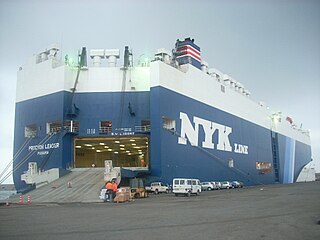
Roll-on/roll-off ships are cargo ships designed to carry wheeled cargo, such as cars, motorcycles, trucks, semi-trailer trucks, buses, trailers, and railroad cars, that are driven on and off the ship on their own wheels or using a platform vehicle, such as a self-propelled modular transporter. This is in contrast to lift-on/lift-off (LoLo) vessels, which use a crane to load and unload cargo.

Götheborg of Sweden is a sailing replica of the Swedish East Indiaman Götheborg I, launched in 1738. All sailors survived when the original ship sank off Gothenburg, Sweden, on 12 September 1745, while approaching the harbour on her return from a third voyage to China. Construction of the replica started in 1995, with the hull launched in 2003, and the rig fully tested for the first time in 2005. Much of the time was spent researching how to rebuild the replica. In 2008, Götheborg completed the first Baltic Sea Tour. It is one of the world's largest operational wooden sailing ships.

A rotor ship is a type of ship designed to use the Magnus effect for propulsion. The ship is propelled, at least in part, by large powered vertical rotors, sometimes known as rotor sails. German engineer Anton Flettner was the first to build a ship that attempted to tap this force for propulsion, and ships using his type of rotor are sometimes known as Flettner ships.

Ulstein Group is a group of companies that focus on various marine-related industries, but is mainly known for its shipbuilding and ship design activities. The largest unit is Ulstein Verft AS. The company's head office and primary operations are located in the town of Ulsteinvik in the municipality of Ulstein in Møre og Romsdal county, Norway, an important area for the Norwegian maritime cluster, and with subsidiaries in several other countries. The group also includes companies working with power & control systems and solutions, engineering, site follow-up and aftermarket services. The company has also been engaged in shipping.
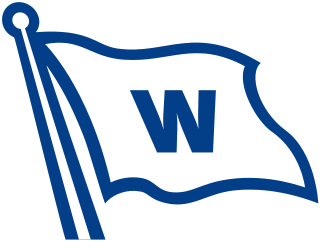
Wilh. Wilhelmsen Holding ASA (WWH) is a Norwegian multinational maritime group, headquartered in Lysaker, Norway. The group employs more than 21,000 people and has operations in 75 nations. The Wilhelmsen group operates the largest maritime network in the world, with over 2200 locations worldwide.

The MV European Causeway is a ferry operated by P&O Ferries. She was built at Mitsubishi Heavy Industries Shimonoseki shipyard in Japan.
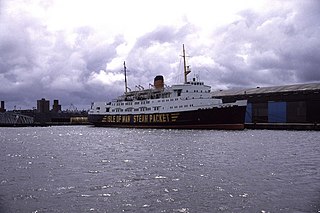
TSS (RMS) Ben-my-Chree (V) was the second of four side-loading car ferries ordered by the Isle of Man Steam Packet Company. Built in 1965, she was the last of their vessels designed with two classes of passenger accommodation and the fifth company vessel to bear the name. She operated until 1984 and was broken up in 1989.

M/V ARC Independence, formerly M/V Faust is a large ro-ro car carrier built in 2007 by Daewoo Shipbuilding & Marine Engineering for Wallenius Lines AB, Sweden. It is currently operated by American Roll-On Roll-Off Carrier (ARC), having formerly served with Wallenius Wilhelmsen Logistics. It is one of the largest car carriers in the world.

MV Tønsberg is a roll-on/roll-off ship owned by Wilh. Wilhelmsen. As of 2012 it is the largest RORO ship in the world.
Wind assisted propulsion is the practice of decreasing the fuel consumption of a merchant vessel through the use of sails or some other wind capture device. Sails used to be the primary means of propelling ships, but with the advent of the steam engine and the diesel engine, sails came to be used for recreational sailing only. In recent years with increasing fuel costs and an increased focus on reducing emissions, there has been increased interest in harnessing the power of the wind to propel commercial ships.
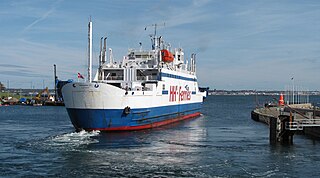
Superflex is a special type of roll-on, roll-off car and lorry ferry. It is specially designed for shorter routes, where the return time in the harbours are an essential part of the crossing time. A superflex ferry uses two decks, within the main hull a rather high deck, well suitable for lorries. This deck is reached from gates that opens in the port. The upper deck can only load cars and other lower vehicles and is accessible through especially designed bridges. Superflex ships distinguish themselves from common car ferries by the use of a command bridge located at the middle of the vessel, and from this command bridge is the ship possible to sail in both directions. Half the ship is a mirror of the other half, the power the engines produces can be used in any end of the ship . Hence Superflex ferries lack a natural prow and stern, and likewise concepts like starboard and port side are ambiguous. Two Superflex ferries are used by Scandlines, they were previously used by HH ferries. But as these two shipping lines merged around 2011, they are now parts of Scandlines at HH Ferry route, one of the most busy international ferry routes in the world. Superflex ferries have been used on several Danish domestic ferry routes, as well as on international routes to Denmark from Germany and Sweden. They are also used between the Caribbean islands.
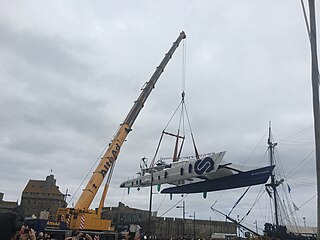
Energy Observer, launched in April 2017, is the first vessel autonomous in energy thanks to a mix of renewable energy and renewable hydrogen produced on board. Developed in collaboration with engineers from the CEA-LITEN the boat will test and prove the efficiency of a full production chain that relies on the coupling of different renewable energies. Following its launch, the boat left in the Spring 2017 for a world tour lasting 6 years in order to optimize its technologies and lead an expedition that will serve durable solutions for energy transition. The boat was nominated first French ambassador of the Sustainable Development Goals by the French Ministry for an ecological and solidary transition.

The E-Flexer is a class of Chinese-built Ro-Pax ferries ordered by Stena RoRo for European line service. Twelve vessels of the class are on order, and upon delivery will be operated by Stena Line, Brittany Ferries, DFDS Seaways and Marine Atlantic. Stena Line are to take five vessels of the class, Brittany Ferries five, and a single vessel each to DFDS and Marine Atlantic, of which the latter's vessel will also be hybrid electric. All of the vessels will be delivered to Stena RoRo with the Stena Line vessels transferred to that company and the Brittany Ferries, DFDS and Marine Atlantic examples long-term chartered to those operators, with an option to purchase at the end of the charter.

Zephyr is a concept of a robotic Venus rover for a mission called Venus Landsailing Rover. This mission concept would place a rover on the surface of Venus that would be propelled by the force of the wind. The rover would be launched together with a Venus orbiter that would perform both communications relay and remote atmospheric studies.
Wallenius Marine is a ship design and ship management company in Sweden. Headquartered in Stockholm, the company has additional offices in Singapore and employs some 800 people.
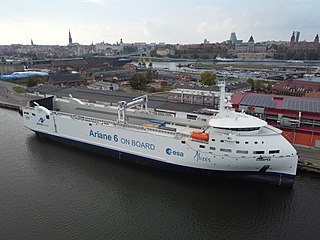
Canopée ("Canopy") is a French freighter ship that is the first sail-propelled merchant vessel. Laid down in 2019 and launched in 2022, it is designed specifically to transport elements of the Ariane 6 rocket from European ports to the Guiana Space Center in Kourou, in South America. It made its first trans-Atlantic crossing in December 2022.




![<span class="mw-page-title-main">K Line</span> Former Japanese shipping company, now [[Ocean Network Express]]](https://upload.wikimedia.org/wikipedia/commons/thumb/1/11/KINISIS_%2846863609164%29.jpg/320px-KINISIS_%2846863609164%29.jpg)













